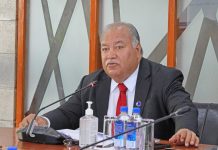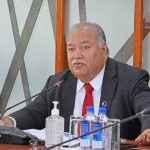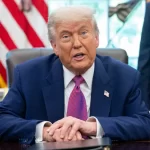Op-ed by Fiamē Naomi Mata’afa
Talofa Lava and warm Pacific greetings. I’m honoured to be given the opportunity to deliver this Pacific Lecture, as has been the tradition for the Lowy Institute to host world leaders in order to foster positive relations between Australia and our respective countries. I have been asked to provide through a Samoa-focused lens, Pacific perspectives on the region’s most pressing challenges and opportunities. And there are a few. The Pacific islands occupy a vast oceanic region that covers almost 20 percent of the Earth’s surface and is home to the world’s largest concentration of microstates. I quote from the renowned Pacific writer, Epeli Hau’ofa: Oceania is us. We are the sea. We are the ocean. We should not be defined by the smallness of our islands, but by the greatness of our oceans.
The Pacific’s three ethnic-geographic sub-regions of Melanesia, Micronesia and Polynesia include 10 sovereign states, five freely-associated states and eight dependent territories. For the Pacific region, and its island countries, the ocean is crucial. Exercising a sense of common identity and purpose linked to the ocean has been critical for protecting and promoting the potential of our shared Pacific Ocean. It is this commonality of the fundamental essence of the region, which has the potential to empower the region through collective and combined agendas and actions. The Blue Pacific narrative will strengthen the existing policy frameworks that harness the ocean as a driver of a transformative socio-cultural, political and economic development of the Pacific. And it gives renewed impetus to deepening Pacific regionalism. We know that we can do more together than alone.
While Pacific countries vary widely in population, economic circumstances, development, political status, and stability, they face several common challenges, each amplified by the devastating impact of the COVID-19 pandemic and the pervasive impacts of climate change. These challenges include political leadership and regionalism, peace and security, economic development, climate change-related impacts, natural disasters, oceans and the environment, technology and connectivity and the intensification of geostrategic competition exacerbating the region’s existing vulnerabilities. At their 2019 meeting in Tuvalu, Forum leaders further highlighted these concerns and subsequently endorsed the development of the 2050 Strategy for the Blue Pacific Continent, a strategy that reinforces commitment and working together as a collective for advancing Pacific regionalism, based on the Blue Pacific Narrative. Pacific Island leaders have nonetheless recognized the need for a new, inclusive and game-changing approach to Pacific regionalism. A regionalism that can not only realize the unmet development needs of Pacific Island peoples but also meet the demands of a new global development paradigm.
At the heart of this approach, is an emphasis on inclusive policy development and implementation, as well as recognition of the political dimension for ensuring development outcomes for the Pacific. The 2050 strategy encapsulates how we can best work together to achieve our shared vision and aspirations. It is based on the firm recognition of the strategic cultural and economic value that our Blue Pacific region holds for us and our shared commitment to protect and leverage this value. Therefore, the newly emerging wave of regionalism maintains a people-centred lens and Pacific control of a regional agenda. It fosters wider political engagement and manoeuvres creatively through and around structures with the common goal of improving the lives of our Pacific peoples.
It seeks to achieve the key objectives of sustainable development that combines economic, social, and cultural development in ways that improve livelihoods and well-being and use the environment sustainably. Economic growth that is inclusive and equitable. Strengthened governance, legal, financial, and administrative systems and security that ensure stable and safe human, environmental and political conditions for all. It expresses the political ambition of our leaders to navigate the Pacific through the global and regional geopolitical forces that impact our region’s ability to achieve development outcomes for our people. In this context, development actors need to work with us, understand the politics of development in our region, and seek to engage with us in a way that supports our agency and leadership on sustainable development. As well, it emphasizes specific leadership and ownership of regional opportunities and challenges.
My country, Samoa, has always advocated for a re-energized and robust Pacific Forum process through which all development partners work, at the regional level, even with the preference to deliver bilaterally. For the member countries, this will add value to the efficacy of their respective prioritisation processes. This has resulted in creating a platform for the PALM process with Japan, the U.S-Pacific Summit and the Korea-Pacific Summit. It is against this background, that we have made all efforts to reconnect our Pacific family, including strengthening our regional institutions. In particular, our premier educational institute, the University of the South Pacific. The USP has contributed significantly towards shaping the framework for Pacific regionalism through intellectual dialogue, and interface with people who are actively engaged in redefining the way the Pacific framework should work. The collaboration between USP and other institutes in the region can leverage research-based sustainable solutions for issues facing the region.
We have learnt from the past examples that are testimony to the strength of our own Pacific diplomacy, which included successful outcomes from the COP21 climate talks in Paris in 2015, the advocacy for the SDG-14 on oceans and the inclusion of loss and damage on the climate change agenda during COP27. Climate change remains the single greatest threat to the well-being, livelihoods, and security of Pacific peoples, taking into account the insufficient global response to limit temperatures below 1.5 degrees Celsius.
As a small island developing state, as well as the chair of the Alliance of Small Island States (AOSIS), we will continue to advocate for ratcheting-up ambitious targets and urgent follow-through in the implementation of the nationally determined contributions. For Samoa, we are aiming to reach a target of 100 percent electrification through renewables by 2030 and to promote the urgent and inclusive transformation of the land and maritime transport sectors towards decarbonisation. The Pacific will remain persistent in urging major emitters to phase out all fossil fuel subsidies and accelerate actions towards transitioning to low greenhouse gas emission climate-resilient economies.
Climate financing is crucial to ensure transformational investments in order to achieve the net zero by 2050 goal. However, we cannot achieve that if funding for the root causes of climate change is exponentially greater than investment in appropriate response to climate change. We continue to see devastating impacts of climate change on our neighbours like Vanuatu, having recently been hit by cyclones Judy and Freddie within a few days. This is our reality. And that is why we will never stop pushing for all to do their part.
Samoa’s role as the chair of the Alliance of Small Island States emphasizes AOSIS’s advocacy role as a strategic necessity and is the thread that binds its work. It must be said that the active engagement of all members, in particular the Pacific members, at the highest political level, is critical to achieving our desired objectives. The Commonwealth has always been a champion for small island developing states and the escalating concerns about the ongoing climate crisis. Samoa will be bringing our Commonwealth family to our Blue Pacific region in 2024, as alluded to by Minister Conroy. There is no better place to discuss solutions and concrete responses to the climate crisis, than in the home of those who stand to lose the most. Similarly, the Pacific offers solidarity to support Australia’s bid for the COP in 2026.
Our Blue Pacific continent is fast becoming an increasingly contested strategic space. The question for us is how prepared are we to tackle the emerging associated challenges. Regional, and national stability has never been more critical in order to maintain peace and security, prosperity and well-being of all Pacific peoples. We are faced with the complexities of varying versions of the Indo-Pacific strategies. The resultant partnerships that have emerged from the diversity of networks and alliances, as well as the underlying lack of understanding of the Pacific countries of how and when the two large ocean spaces morphed into the Indo-Pacific, and the rationale behind the concept. Why? Because this is the basis of the geo-strategic approaches of the development partners working in the region.
I feel I need to be very frank and say to this gathering tonight, that in the Pacific, we feel our partners have fallen short of acknowledging the integrity of Pacific leadership, and the responsibility they carry for every decision made as a collective, and individually, in order to garner support for the sustainable development of our nations. Such acknowledgements can simply be in the form of information sharing, and open consultation if we consider ourselves as a Pacific family, and looking to find solutions in the Pacific way. The shifting global and regional geopolitics is creating an increasingly complex and crowded region that places the Pacific at the centre of contemporary global geopolitics. This trend, coupled with broader challenges, such as climate change and disaster risk, rising inequalities, resource depletion, maritime boundary disputes, and advances in technology will continue to shape the Pacific regional security environment.
Pacific Island Forum members have a proud history of working collectively in response to events and issues that have challenged regional security, peace and stability in the past. The Pacific region’s current geopolitical and geostrategic context underlines the need for an integrated and comprehensive security architecture, incorporating an expanded concept of security. A stable and resilient security environment provides the platform for achieving the region’s sustainable development aspirations. We welcome the efforts by some of our development actors to keep the Pacific countries consistently informed of security developments specific to their countries, but which can have a potential impact on the Pacific region.
On that note, I was very fortunate to have a security briefing from your security teams. And I’m very thankful for the sharing of that information. While we may become an unwilling actor in the current tensions around the Pacific Rim by virtue of our geography, it may be pertinent to ask how our region can assert our geography as the basis for promoting regional and global peace, as was done with the work of the Rarotonga Treaty.
In terms of economic growth, I wish to acknowledge Australia and New Zealand’s support towards the post-COVID recovery through the important contribution of labour mobility and what it makes to the economy of all participating countries. While considering the nuances of expanding labour mobility, we must ensure that we maximize the benefits and minimize any negative impacts on the livelihoods and business domestically in labour-sending countries. It is important that regular consultations take place and that there is the opportunity to review from time to time the efficacy of the schemes to ensure unfair disadvantage of either side.
Pacific countries with limited human resource capacities cannot sustain development efforts with regular brain drain. Of great importance to Pacific-sending countries is the commitment to ensure that workers’ rights and welfare conditions are socialised, safeguarded and implemented in a timely manner. It is also important to note that in terms of development cooperation, Australia recognizes the importance of long-term commitments and predictability, to effective planning and sustainable change for partner countries, and has instituted agreed-to arrangements to facilitate pilot policy shifts, as well as accepting the integrity of the use of partner country systems. It is also important to maintain close communication and cooperation in order to shape policies and institutions to drive inclusive and sustainable economic growth, including working closely with all willing development partners through processes such as the Joint Policy Action Matrix dialogue. Such a process encapsulates the advancing of economic reforms to achieve sustainable growth and prudent debt management.
All PACER Plus signatory countries are committed to closer regional economic integration through working together and with the PACER Plus implementation unit based in Apia to drive the implementation of PACER Plus and facilitate the flow of goods, services, capital and people across signatory countries. We will also collaborate on biosecurity and market access to enhance trade flows. We very much look forward to stronger partnerships for economic growth, security, and stronger relationships between our people. There is a clear need to reinforce and support existing and promising approaches, particularly those that are non-partisan and non-interventionist.
In closing, let me again express my appreciation for the invitation to deliver some Pacific perspectives of the region we share. I would also like to acknowledge the assistance which has been provided by the Australian education and research institutions to the Pacific countries and to Samoa, in particular, since the end of the Second World War. At a time when the Pacific is in need of research on so many issues of vital importance to the Pacific, it is the Lowy Institute that has filled in some of the very important research gaps by placing significant focus on the Pacific region. But I do have to say, Michael, mostly in Melanesia. I wish again to thank the Lowy Institute, all the best for your very important work as we move into the future. And I want to acknowledge all of you, and thank you as colleagues, for your interest in the Blue Pacific, and its future development, thank you, fa’afetai lava.
SOURCE: SAMOA OBSERVER/PACNEWS















